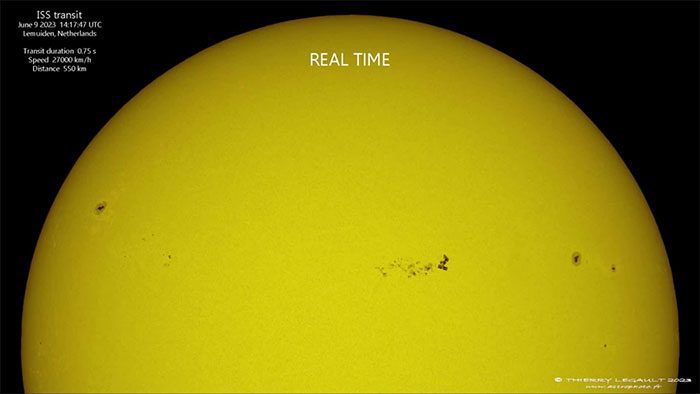Thierry Legault, a French astrophotographer, used a telescope to capture images of the International Space Station (ISS) passing in front of the Sun on June 9.
The ISS passes in front of clusters of sunspots. (Video: Thierry Legault).
Traveling at about 28,000 km/h, the ISS completes an orbit around Earth in approximately 90 minutes or so, but it only passes in front of the Sun for about 0.75 seconds. As a result, capturing high-resolution images like Legault’s is extremely challenging, according to Business Insider on June 14.
“The crossing lasts less than a second,” Legault stated. He was fortunate to capture this moment just 45 minutes before a large cloud moved in to obscure the Sun.
In the footage, the ISS passes in front of three clusters of sunspots, one of which is large enough to engulf Earth. At this time, NASA astronauts Stephen Bowen and Warren Hoburg were also stepping outside the station to install new solar panels.

The ISS passes in front of three clusters of sunspots.
In the video, the ISS appears to be very close to the Sun, but in reality, the distance is immense. The ISS orbits Earth at an altitude of about 400 km, while the Sun is located approximately 150 million km away.
Sunspots appear darker because they are cooler than other areas on the Sun’s surface, according to NASA. These cooler areas form where strong magnetic fields inhibit heat from reaching the Sun’s surface. In sunspots, the magnetic field is unstable and can trigger solar flares — powerful explosions that release energy and high-speed particles into space. Solar flares can create impressive auroras but can also disrupt radio waves on Earth. Strong solar flares can even affect satellites, communication systems, power grids, and in severe cases, cause blackouts.
According to NASA, charged particles from solar flares can also pose radiation risks to astronauts, especially when they venture outside the ISS for spacewalks. As a result, scientists carefully monitor solar flares, and NASA may cancel spacewalks before these particles reach Earth to ensure astronaut safety.





















































